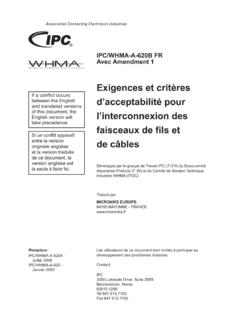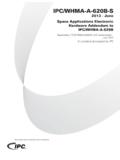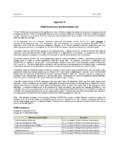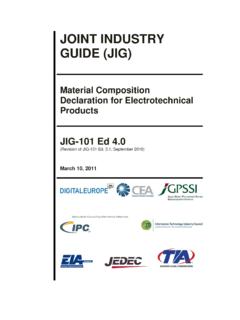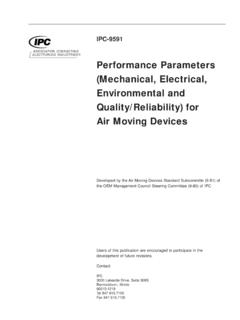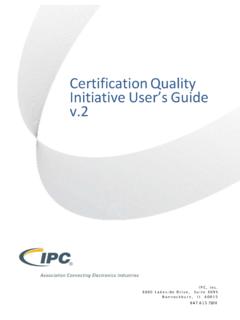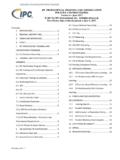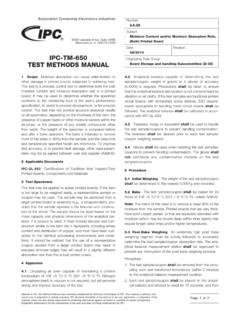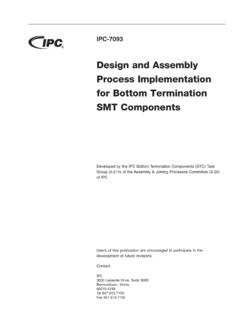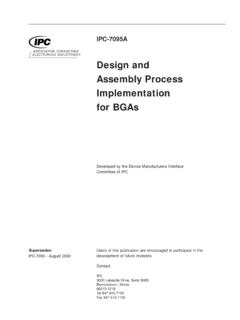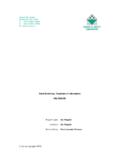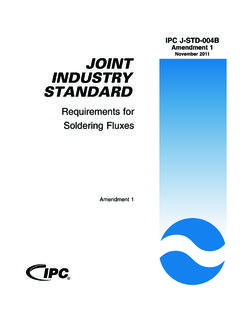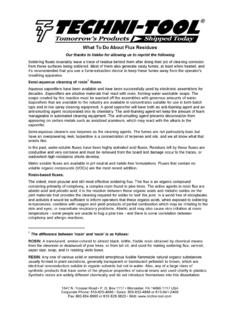Transcription of J-STD-002D Solderability Tests for Component Leads ...
1 J- STD- 002d solderability tests for component leads , Terminations, Lugs, Terminals and Wires Proposed Standard for Ballot October 2011 J- STD-002D Proposed Standard for Ballot October 2011 2 1 SCOPE Scope This standard prescribes test methods, defect definitions, acceptance criteria, and illustrations for assessing the Solderability of electronic Component Leads , terminations, solid wires, stranded wires, lugs, and tabs. This standard also includes a test method for the Resistance to Dissolution/Dewetting of Metallization. This standard is intended for use by both vendor and user. Purpose Solderability evaluations are made to verify that the Solderability of Component Leads and terminations meets the requirements established in this standard and to determine that storage has had no adverse effect on the ability to solder components to an interconnecting substrate.
2 Determination of Solderability can be made at the time of manufacture, at receipt of the components by the user, or just before assembly and soldering. The resistance to dissolution of metallization determination is made to verify that metallized terminations will remain intact throughout the assembly soldering processes. Shall and Should The word shall is used in the text of this document wherever there is a requirement for materials, preparation, process control or acceptance of a soldered connection or a test method. The word should reflects recommendations and is used to reflect general industry practices and procedures for guidance only. Document Hierarchy In the event of conflict, the following decreasing order of precedence applies: 1. Procurement AABUS. 2. Master drawing or master assembly drawing reflecting the user s detailed requirements. 3. When invoked by the customer or per contractual agreement, this document, J-STD-002.
3 4. Other documents to extent specified by the customer. Method Classification This standard describes methods by which Component Leads or terminations may be evaluated for Solderability . Test A, Test B, Test C, Test D and Test S for tin/lead solder processes and Test A1, Test B1, Test C1, Test D and Test S1 for lead-free solder processes, unless otherwise AABUS, are to be used for each application as a default. Visual Acceptance Criteria Tests Test A Solder Bath/Dip and Look Test (Leaded Components and Stranded Wires) Tin/Lead Solder (paragraph ) Test B Solder Bath/Dip and Look Test (Leadless Components) Tin/Lead Solder (paragraph ) Test C Wrapped Wires Test (Lugs, Tabs, Hooked Leads , and Turrets) Tin/Lead Solder (paragraph ) Test D Resistance to Dissolution/Dewetting of Metallization Test Tin/Lead Solder and Lead-free Solder (paragraph ) Test S Surface Mount Process Simulation Test Tin/Lead Solder (paragraph ) Test A1 Solder Bath/Dip and Look Test (Leaded Components and Stranded Wires) Lead-free Solder (paragraph ) Test B1 Solder Bath/Dip and Look Test (Leadless Components) Lead-free Solder (paragraph ) Test C1 Wrapped Wires Test (Lugs, Tabs, Hooked Leads , and Turrets) Lead-free Solder (paragraph )
4 Test S1 Surface Mount Process Simulation Test Lead-free Solder (paragraph ) Force Measurement Tests Test E Wetting Balance Solder Pot Test (Leaded Components) Tin/Lead Solder (paragraph ) Test F Wetting Balance Solder Pot Test (Leadless Components) Tin/Lead Solder (paragraph ) Test G Wetting Balance Globule Test Tin/Lead Solder (paragraph ) Test E1 Wetting Balance Solder Pot Test (Leaded Components) Lead-free Solder (paragraph ) Test F1 Wetting Balance Solder Pot Test (Leadless Components) Lead-free Solder (paragraph ) Test G1 Wetting Balance Globule Test Lead-free Solder (paragraph ) These methods ( ) are included for evaluation purposes only. Data collected should be submitted to the IPC Wetting Balance Task Group for correlation and analysis. Tests E, F, G, E1, F1 and G1 shall not be used for acceptance/rejection without user and vendor agreement.
5 Coating Durability The following are guidelines, not specification requirements, for determining the needed level of preconditioning c ategory assurance (see Table 3-3). The Coating Durability guidelines describe two broad usage sectors and are not intended to encompass all possible product use scenarios. The user and vendor need to agree on the coating durability requirements. Coating Durability Category 2 is the default condition for all Component finishes. J- STD-002D Proposed Standard for Ballot October 2011 3 Category 1 Minimum Coating Durability Intended for surfaces that will be soldered within a short period of time ( , up to six months) from the time of testing and are likely to experience a minimum of thermal exposures before soldering. No Preconditioning category per Table 3-3. Category 2 Typical Coating Durability Intended for surfaces whose Solderability may become degraded from storage of longer than six months or from multiple thermal exposures.
6 This is preconditioning category E per Table 3-3. Solderability Backwards Compatibility Typically Pb containing terminations are evaluated using SnPb Solderability test conditions and Pb-free terminations use Pb-free test conditions. If Pb-free terminations are to be used in a SnPb solder process (backward compatibility) then they should be evaluated using test parameters consistent with standard SnPb solder conditions. The backward compatibility test does not apply to Pb-free BGA type packages. Referee Verification Solder Dip for Tests A, B, C, A1, B1, C1 When the dipped portion of the termination exhibits anomalies such as surface roughness, or dross, or anomalies that may have been induced by improper solder dipping, a referee verification solder dip of the suspect anomaly may be necessary. Upon reinspection, if the suspect anomaly has been removed, the anomaly will have been verified as a non-rejectable cosmetic surface defect.
7 If the anomaly persists, regardless of area, it shall be classified a rejectable Solderability defect. This procedure may only be used on one Component per lot. Continuous need of Referee Verification Solder Dip procedure is an indication of either improper testing procedure, examination interpretation, or of poor Component quality. Limitations This standard shall not be construed as a production procedure for the pre-tinning of Leads and terminations. Solderability testing of components is considered a destructive test and the tested Component should not be used for functional electrical evaluation. Components after such Solderability testing, shall only be used AABUS. Contractual Agreement In cases where the stated test parameters are inappropriate or insufficient, alternative parameters may be AABUS. 2 APPLICABLE DOCUMENTS The following documents of the issue currently in effect form a part of this standard to the extent specified herein.
8 Industry IPC1 IPC-T-50 Terms and Definitions IPC-TR-464 Accelerated Aging for Solderability Evaluations and Addendum J- STD-004 Requirements for Soldering Fluxes J- STD-005 Requirements for Soldering Pastes J- STD-006 Requirements for Electronic Grade Solder Alloys and Fluxed and Non-Fluxed Solid Solder for Electronic Soldering Applications IPC-TM-650 Test Methods Manual International Electrotechnical Commission2 IEC 60068-2-69 Environmental testing - Part 2-69: Tests - Test Te: Solderability testing of electronic components for surface mounting devices (SMD) by the wetting balance method Government Federal (CID) A-A-59551 Wires, Electrical, Copper (Uninsulated) 1 2 J- STD-002D Proposed Standard for Ballot October 2011 4 3 REQUIREMENTS Terms and Definitions The definition of terms shall be in accordance with IPC-T-50.
9 Terms repeated from IPC-T-50 are indicated by an asterisk (*). AABUS As agreed by user and supplier. Dewetting* A condition that results when molten solder coats a surface and then recedes to leave irregularly-shaped mounds of solder that are separated by areas that are covered with a thin film of solder and with the basis metal not exposed. Dissolution of Component Metallization (Leaching) The loss or removal of metallization from an area on the basis or substrate material after immersion in molten solder. Equilibrium Wetting The degree of wetting in which the forces of wetting are in balance with the forces of gravity. Note: This wetting is visible when the wetting balance curve flattens out and approaches zero slope (see Figure 4-10). Nonwetting, Solder* The partial adherence of molten solder to a surface that it has contacted while leaving some basis metal exposed.
10 Pinhole* An imperfection in the form of a small hole that penetrates through a layer of material. Solderability * The ability of a metal to be wetted by molten solder. Solder Connection Pinhole* A small hole that penetrates from the surface of a solder connection to a void of indeterminate size within the solder connection. Wetting, Solder* The formation of a relatively uniform, smooth, unbroken, and adherent film of solder to a basis metal. Materials All chemicals shall be of commercial grade or better. Fresh solvents shall be used as often as is necessary to preclude contamination. Solder For tin/lead testing, the solder composition shall be Sn60Pb40 or Sn63Pb37 per J-STD-006. The composition of the solder, including contamination levels, shall be maintained during testing per For lead-free testing, the solder composition shall be , allowing variation of the Ag content between wt% and Cu content between wt% with the balance being Sn per J-STD-006.
